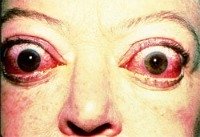|
Thyroid Eye Disease
Does one or both of your eyes appear to bulge out? Have you experienced sudden Diplopia? Have you experienced decreased vision? Put together, these symptoms may point to Thyroid Eye Disease. What is Thyroid Eye Disease (TED)?
TED is marked by autoimmune inflammation of the orbital musculature and fat. This swelling of the soft tissues around the eyes increases the bulk of the orbital contents. This bulkiness leads to the bulging out of the eyes. The bulging out of the eyes and the lid retraction caused by TED leads to excessive Dry Eyes from exposure. Instead of the lids closing over the eyes to provide proper lubrication, part of the cornea may be left exposed to the air, leading to dryness. The bulkiness of the orbital contents increases orbital tension since the orbit is a confined space. This can lead to Optic Nerve compression and consequently, vision loss. In essence, your Optic Nerve can be squeezed from the pressure of the orbital content bulkiness. Eye movements can also be affected, initially by muscle inflammation and later in the disease by fibrosis (a thickening and scarring of connective tissue). What causes Thyroid Eye Disease ?
The following non-ocular factors may trigger and drive the orbital muscle inflammation: TED can cause facial disfigurement and/or decreased vision, which can impact employment, hobbies and psychosocial aspects of life. Treatments for TED are often not complete, leaving those afflicted with residual effects long after the completion of the treatment.
What are symptoms of Thyroid Eye Disease ?
Common symptoms include: If the swelling of the muscles is significant, the enlarged muscles can compress the Optic Nerve resulting in: The active swelling subsides after several months. However, you may be left with some bulging out of the eyes, lid retraction or Diplopia that may require additional treatment. How is Thyroid Eye Disease diagnosed, managed and treated?
Your eye doctor will conduct a comprehensive eye examination to include a careful history of your symptoms and findings. Your Cornea will be checked for excessive dryness, along with your lids, eye movements and Optic Nerve. Exophthalmometry may be done to check if one or both of your eyes protrude more than average. Your eye doctor may perform Visual Field, Color Vision and Pupil testing to rule out any damage to your nerve. Based on the findings of the exam, your Dry Eyes will be treated with lubricants or other therapies as appropriate. Your Diplopia will be managed with glasses, prisms, or patching in order to make your vision more comfortable. The next critical part of the treatment plan is to rule out underlying drivers to this inflammatory process. Such nonspecific drivers include smoking, bacteria, and tumors. You will be referred to an internist to rule out such drivers as endocrine imbalance, infection or malignancy. Some of the diagnostic tests that you should expect to have to undergo in order to find an underlying cause to your illness include: For years, the main treatment was to use high doses of oral steroids. However, studies have shown that intravenous steroids with oral cyclosporine may be as effective with reduced doses of oral steroids and some propose omitting the oral steroids altogether. If the swelling behind the eye is severe enough, surgery is an option that may be necessary to decompress the orbit. This procedure involves removing part of the bony orbit and fat behind the eye to relieve pressure within the eye socket and therefore prevent damage to the Optic Nerve. Also, this allows the eyes to move back into a more normal position in the eye socket. As mentioned earlier, some patients may be left with residual effects from TED even after treatment, and surgery may be an option. For example, if your eyes remain misaligned, you may have eye muscle surgery to reposition the enlarged muscles that control eye movement. Another option is eyelid surgery to adjust the position of retracted lids in order to improve eyelid closure and restore eyelid function. Your eyelids can also improve in appearance if the surgeon removes excessive fat from them. Remember that it is normal to struggle emotionally with the alteration in your appearance and/or any decreased vision or other vision problems created by TED, especially if it has impacted your employment, hobbies or other aspects of your life. Don’t hesitate to seek help from a mental health provider, not only to talk about your feelings, but to learn of coping strategies and to join support groups with others afflicted with TED as well. |





